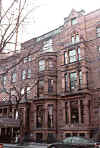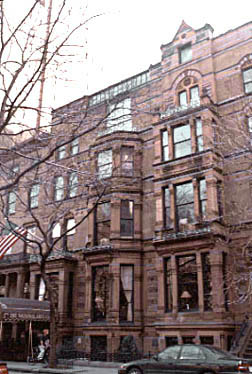 |
New York Architecture Images-Gramercy Park National Arts Club |
||||||||||||||||||||||||||||||||||||||||||||||||||||
|
architect |
remodeled by Calvert Vaux | ||||||||||||||||||||||||||||||||||||||||||||||||||||
|
location |
15 Gramercy Park South | ||||||||||||||||||||||||||||||||||||||||||||||||||||
|
date |
1885 | ||||||||||||||||||||||||||||||||||||||||||||||||||||
|
style |
Renaissance Revival | ||||||||||||||||||||||||||||||||||||||||||||||||||||
|
construction |
Brownstone | ||||||||||||||||||||||||||||||||||||||||||||||||||||
|
type |
House | ||||||||||||||||||||||||||||||||||||||||||||||||||||
|
|
|||||||||||||||||||||||||||||||||||||||||||||||||||||
|
images |
 |
||||||||||||||||||||||||||||||||||||||||||||||||||||
|
|
|
||||||||||||||||||||||||||||||||||||||||||||||||||||
|
notes |
Samuel Tilden (an eminent lawyer, reformer and governor of New York State [1875-6]) commissioned Calvert Vaux (Frederick Law Olmsted's collaborator on Central Park) to combine and remodel two adjacent row houses facing the park. A proponent of the High Victorian Gothic style, which was influenced by Ruskin's theories on architecture, Vaux transformed the building's facade into a complex, asymmetrical composition with historical details, polychromy and botanical ornament. Sculptural busts of Shakespeare, Milton, Franklin, Goethe and Dante project from the facade and allude to Tilden's library--books that would eventually become part of the New York Public Library's core collection. Today, the building houses the National Arts Club. | ||||||||||||||||||||||||||||||||||||||||||||||||||||
The Tilden Mansion - National Arts Club( Originally Published 1921 ) The next club to recognize the advantages of the Park as a site was the National Arts Club which acquired the Tilden Mansion, Nos. 14 and 15, with its garden extending to 19th Street, upon which has since been erected an apartment house for the use of members of the Club. During its occupancy, the Club has not only done much "to promote the mutual acquaintance of art lovers and art workers," but also to create a colony of artists around the Park and in its vicinity. In 1905, the Columbia University Club purchased the house No. 18 Gramercy Park at the corner of Irving Place, which had been built by Luther C. Clark in 1853, and upon its removal to larger quarters in 1917, the house was taken by the Army and Navy Club which now occupies it. A year or two later the Princeton Club rented the house on the northerly side of the Park at the corner of Lexington Avenue, formerly the home of Stanford White, and was followed by the United Service Club, made up of officers of all the allied armies, during the continuance of the war. The "Tech Club," composed of graduates of the Massachusetts Institute of Technology, occupies the old Gerard House, adjoining the Columbia Club. Another of the group is "De Hollandsche Club" (The Netherland Club) which purchased No. 4 in 1913 and aims to make it the center of the activities of the Hollanders in this city. The sight of the orange, white and blue flag which is occasionally displayed on the Park flag pole should assure its members that their presence is welcome. The membership of the various clubs represents every phase of art and literature, and philanthropy has its special place in the hotel for the women workers of the New York City Mission and Tract Society, built by Mrs. John S. Kennedy at the westerly end of the Park. Nor is the Park without its place in literature, for Arthur B. Maur-ice in "New York in Fiction" tells us that No. 2 was the residence of "Mrs. Leroy" in Hopkinson Smith's "Caleb West," and that the most dramatic scene in the novel of Edgar Saltus, "The Truth about Tristram Varick" was laid in the old Field house. Had he been spared but a little longer, the Park would surely have found its poet laureate in Richard Watson Gilder, who for all too brief a stay, looked down from his library window upon its trees and lawns with a fond enjoyment which could not have failed to inspire his verse. So many men and women, well known in their time, and representing much that was best in the life of the City, have been Park dwellers that it is impossible to do more than add a few names to those already mentioned, but among these should be included Clarkson N. Potter, a son of Bishop Alonzo Potter, who was an influential member of Congress for ten years and President of the American Bar Association ; Henry H. Anderson a prominent lawyer and President for many years of the University Club; Robert G. Ingersoll, who nominated James G. Blaine at the Republican Convention of 1876 in a speech which brought him national fame as an orator; James A. Scrymser, who was the successor of Cyrus W. Field as the promoter of ocean cables, and established cable communications with Central and South America and Mexico ; and William Gaston Hamilton, a grandson of Alexander Hamilton, who as an engineer was associated with his neighbor, Mr. Scrymser, in his cable undertakings. Nor should it be forgotten that at No. 10, as early as 1851, Miss Henrietta B. Haines established her famous school for girls which for many years was the fashion-able source of education of the young womanhood of New York, and was supposed to add the highest finish to the charms of Nature. Let us hope that some of her pupils have left descendants among that army of babies, who have been sunned in their carriages or among the generations of boys and girls who have played and romped in the Park, and unconsciously revelled in its air and sunshine since Dr. Hawks reminded Mr. Ruggles that "Man makes buildings but God makes space." Two historic names are so closely associated with the Park that they cannot be omitted, although they were not dwellers on the Park ; Washington Irving, who lived for a time at the corner of Seventeenth Street and Irving Place,' which identifies his name with the neighborhood ; and Theodore Roosevelt, who was born and lived during his boyhood but one block distant, in Twentieth Street, at No. 28, which is to be preserved as a memorial of him. No great stretch of the imagination is needed to visualise the genial author of the Knickerbocker History and the youthful President of the United States in the long procession of old and young which the Park has welcomed within its gates. As a park given to the prospective owners of the land surrounding it and held in trust for those who have made their homes around it, Gramercy Park is unique in this City, and perhaps in this country, and represents the only neighborhood, with possibly one exception, which has remained comparatively unchanged for more than eighty years. In a city where the tide of progress has swept from the Battery, once the center of social life, almost to the Harlem so relentlessly that but few traces have been left of the family life of a former century, the Park is one of the City's land-marks. Walled in by skyscrapers and looked down upon by the Metropolitan tower, the Park preserves its quiet seclusion, and its trees and lawns bring new cheer to its residents and passers-by with every recurring spring; rising generations continue to discover in it a happy playground, and perhaps a few of the older generation recall the men and women whose lives are interwoven in its history. |
|||||||||||||||||||||||||||||||||||||||||||||||||||||
|
I arrived at my destination, The National Arts
Club, a National Historic Landmark at 15 Gramercy Park South. Built in
1844, its warm brown façade is one of the more beautiful in the area.
New York Gov. Samuel Tilden bought the building for $37,500 in 1863,
along with the lot behind it on 19th Street. Eleven years later, he
purchased the house next door, built at the same time, and converted
both into a single residence still known as the Tilden Mansion. Two
years after his second purchase, he was the Democratic Party's nominee
for president, and, reminiscent of the last U.S. presidential election,
won the popular vote, but lost the election in the Electoral College by
one vote; though colleagues begged him, he refused to contest the
election.
Members of The National Arts Club, which was founded in 1893 by Charles de Kay, literary and art critic for 18 years at The New York Times, bought the building in 1906. Tilden's large dining room was converted into a gallery, as were two other rooms, and public exhibitions are held all year at this private club for artists and those who support the arts. Its stated mission is to stimulate and "promote public interest in the arts and educate the American people in the fine arts." Camera flopping around my neck, gripping my umbrella tightly and with fist clenched on the brown bag holding my pastrami sandwich, I crossed the street to The National Arts Club, welcomed by the lights shining through its large bay window. I wanted to sit in the warm room on the other side of that window for a few minutes and watch the snow fall in the park. It was good to be back in New York City. Rolland Golden The Times Picayune www.rollandgolden.com |
|||||||||||||||||||||||||||||||||||||||||||||||||||||
|
SAMUEL TILDEN
A leading corporation lawyer and
DEMOCRATIC
politician, Samuel Jones Tilden, b. New Lebanon, N.Y.,
Feb. 9, 1814, d. Aug. 4, 1886, was governor of New York (1874-76)
and the Democratic candidate for PRESIDENT OF THE UNITED STATES in the
contested election of 1876. He attended law school in New York, was
admitted to the bar in 1841, and became corporation counsel for New York
City in 1843. In 1846 he served in the New York state legislature and
was a member of the state constitutional convention. Tilden gained political prominence while chairman of the New York State Democratic Committee (1866-74). He actively supported the Democratic presidential tickets in 1868 and 1872. Late in 1871 he moved to the forefront of the campaign to drive William M. Tweed's corrupt New York City political machine from power. Tilden's anti-Tweed activities established his credentials as a reformer, although his critics noted that he had initially been reluctant to join the anti-Tweed cause. In 1874, campaigning under a reform banner, Tilden was elected governor of New York. He attacked corruption in state politics and sought to bring about a general reduction of state expenditures. On national issues, he criticized Radical Reconstruction policy and advocated a hard-money policy. As the Democratic presidential nominee in 1876, Tilden won a 50,000-vote plurality but lost the election when the disputed ELECTORAL votes of four states were awarded by a special commission to Republican candidate Rutherford B. HAYES. Although Tilden believed he had been cheated out of the presidency, he acquiesced in the result, largely withdrawing from active political life thereafter. He left most of his $6 million estate to New York City for the establishment of a free public library. -- Gerald W. McFarland For Further Reading: The National Arts Club displays a bronze bust of Tilden, and even a campaign poster of "Tilden for President" in the Trask Gallery.
|
|||||||||||||||||||||||||||||||||||||||||||||||||||||
|
links |
|||||||||||||||||||||||||||||||||||||||||||||||||||||